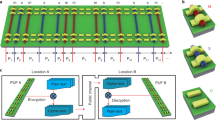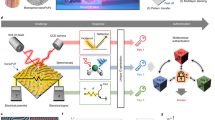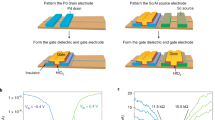Abstract
Information security underpins many aspects of modern society. However, silicon chips are vulnerable to hazards such as counterfeiting, tampering and information leakage through side-channel attacks (for example, by measuring power consumption, timing or electromagnetic radiation). Single-walled carbon nanotubes are a potential replacement for silicon as the channel material of transistors due to their superb electrical properties and intrinsic ultrathin body, but problems such as limited semiconducting purity and non-ideal assembly still need to be addressed before they can deliver high-performance electronics. Here, we show that by using these inherent imperfections, an unclonable electronic random structure can be constructed at low cost from carbon nanotubes. The nanotubes are self-assembled into patterned HfO2 trenches using ion-exchange chemistry, and the width of the trench is optimized to maximize the randomness of the nanotube placement. With this approach, two-dimensional (2D) random bit arrays are created that can offer ternary-bit architecture by determining the connection yield and switching type of the nanotube devices. As a result, our cryptographic keys provide a significantly higher level of security than conventional binary-bit architecture with the same key size.
This is a preview of subscription content, access via your institution
Access options
Subscribe to this journal
Receive 12 print issues and online access
$259.00 per year
only $21.58 per issue
Buy this article
- Purchase on Springer Link
- Instant access to full article PDF
Prices may be subject to local taxes which are calculated during checkout





Similar content being viewed by others
References
Ruhrmair, U., Devadas, S. & Koushanfar, F. in Introduction to Hardware Security and Trust (eds Tehranipoor, M. & Wang, C.) 65–102 (Springer, 2012).
Pappu, R., Recht, B., Taylor, J. & Gershenfeld, N. Physical one-way functions. Science 297, 2026–2030 (2002).
Horstmeyer, R., Judkewitz, B., Vellekoop, I. M., Assawaworrarit, S. & Yang, C. Physical key-protected one-time pad. Sci. Rep. 3, 3543 (2013).
Marangon, D. G., Vallone, G. & Villoresi, P. Random bits, true and unbiased, from atmospheric turbulence. Sci. Rep. 4, 5490 (2014).
Buchanan, J. D. R. et al. Forgery: ‘fingerprinting’ documents and packaging. Nature 436, 475 (2005).
Gassend, B., Clarke, D., van Dijk, M. & Devadas, S. Silicon physical random functions. In Proc. 9th ACM Conf. Comput. Commun. Secur. (Ed. Atluri, V.) 148–160 (ACM Press, 2002).
Maes, R. & Verbauwhede, I. Towards Hardware-Intrinsic Security 3–96 (Springer, 2010).
Bolotnyy, L. & Robins, G. Physically unclonable function-based security and privacy in RFID systems. In Fifth Ann. IEEE Int. Conf. Pervasive Comput. Commun. 211–220 (IEEE, 2007).
Guajardo, J., Kumar, S. S., Schrijen, G.-J. & Tuyls, P. FPGA intrinsic PUFs and their use for IP protection. In Cryptogr. Hardw. Embed. Syst. - CHES 2007 (eds Paillier, P. & Verbauwhede, I.) 63–80 (Springer, 2007).
Katzenbeisser, S. et al. in Lecture Notes in Computer Science Vol. 7428 (eds Prouff, E. & Schaumont, P.) 283–301 (2012).
Armknecht, F., Maes, R., Sadeghi, A. R., Sunar, B. & Tuyls, P. in Lecture Notes in Computer Science Vol. 5912 (ed. Matsui, M.) 685–702 (2009).
Koeberl, P., Li, J. & Wu, W. in Lecture Notes in Computer Science Vol. 8292 (eds Bloem, R. & Lipp, P.) 36–52 (2013).
Bhargava, M. & Mai, K. An efficient reliable PUF-based cryptographic key generator in 65 nm CMOS. In Des. Autom. Test Eur. Conf. Exhib. 2014 1–6 (IEEE, 2014).
Yu, M. D. & Devadas, S. Secure and robust error correction for physical unclonable functions. IEEE Des. Test Comput. 27, 48–65 (2010).
Bösch, C., Guajardo, J., Sadeghi, A. R., Shokrollahi, J. & Tuyls, P. in Lecture Notes in Computer Science Vol. 5154 (eds Oswald, E. & Rohatgi, P.) 181–197 (2008).
Delvaux, J., Gu, D., Schellekens, D. & Verbauwhede, I. Helper data algorithms for PUF-based key generation: overview and analysis. IEEE Trans. Comput. Des. Integr. Circuits Syst. 34, 889–902 (2015).
Akinwande, D., Petrone, N. & Hone, J. Two-dimensional flexible nanoelectronics. Nature Commun. 5, 5678 (2014).
Moon, H. et al. Synthesis of ultrathin polymer insulating layers by initiated chemical vapour deposition for low-power soft electronics. Nature Mater. 14, 628–635 (2015).
Lau, P. H. et al. Fully printed, high performance carbon nanotube thin-film transistors on flexible substrates. Nano Lett. 13, 3864–3869 (2013).
Siegel, A. C. et al. Foldable printed circuit boards on paper substrates. Adv. Funct. Mater. 20, 28–35 (2010).
Rose, G. S. et al. Hardware security strategies exploiting nanoelectronic circuits. In 18th Asia South Pacific Des. Autom. Conf. 368–372 (IEEE, 2013).
Rose, G. S. et al. in Networks in Cyber Security Vol. 55 (Ed. Pino, R. E.) 105–123 (Springer, 2014).
Yoon, B. et al. Recent functional material based approaches to prevent and detect counterfeiting. J. Mater. Chem. C 1, 2388–2403 (2013).
Demirok, U. K., Burdick, J. & Wang, J. Orthogonal multi-readout identification of alloy nanowire barcodes. J. Am. Chem. Soc. 131, 22–23 (2009).
Kim, J. et al. Anti-counterfeit nanoscale fingerprints based on randomly distributed nanowires. Nanotechnology 25, 155303 (2014).
Wendt, J. B. & Potkonjak, M. Nanotechnology-based trusted remote sensing. In Proc. 2011 IEEE Sensors 1213–1216 (IEEE, 2011).
Edelstein, D. C., Fritz, G. M., Gates, S. M. & Pfeiffer, D. Structure with sub-lithographic random conductors as a physical unclonable function. US patent 8,759,976 (2014).
Rajendran, J., Rose, G. S., Karri, R. & Potkonjak, M. Nano-PPUF: a memristor-based security primitive. In 2012 IEEE Comput. Soc. Annu. Symp. VLSI 84–87 (IEEE, 2012).
Rose, G. S., McDonald, N., Yan, L. K. & Wysocki, B. A write-time based memristive PUF for hardware security applications. In IEEE/ACM Int. Conf. Comput. Des. Dig. Tech. Pap. 830–833 (IEEE, 2013).
Rukhin, A. et al. Statistical Test Suite for Random and Pseudorando Number Generators for Cryptographic Applications Special Publication 800-22 Revision 1a (NIST, 2010); http://csrc.nist.gov/groups/ST/toolkit/rng/documents/SP800-22rev1a.pdf
Uchida, A. et al. Fast physical random bit generation with chaotic semiconductor lasers. Nature Photon. 2, 728–732 (2008).
Kanter, I., Aviad, Y., Reidler, I., Cohen, E. & Rosenbluh, M. An optical ultrafast random bit generator. Nature Photon. 4, 58–61 (2009).
Park, H. et al. High-density integration of carbon nanotubes via chemical self-assembly. Nature Nanotech. 7, 787–791 (2012).
Klinke, C., Hannon, J. B., Afzali, A. & Avouris, P. Field-effect transistors assembled from functionalized carbon nanotubes. Nano Lett. 6, 906–910 (2006).
Tulevski, G. S. et al. Chemically assisted directed assembly of carbon nanotubes for the fabrication of large-scale device arrays. J. Am. Chem. Soc. 129, 11964–11968 (2007).
Suh, G. E. & Devadas, S. Physical unclonable functions for device authentication and secret key generation. In Proc. 44th Annu. Conf. Des. Autom. 9–14 (ACM Press, 2007).
Yang, F. et al. Chirality-specific growth of single-walled carbon nanotubes on solid alloy catalysts. Nature 510, 522–524 (2014).
Pei, T. et al. Temperature performance of doping-free top-gate CNT field-effect transistors: potential for low- and high-temperature electronics. Adv. Funct. Mater. 21, 1843–1849 (2011).
Han, S.-J. et al. Carbon nanotube complementary logic based on Erbium contacts and self-assembled high purity solution tubes. In Proc. 2013 IEEE Int. Electron Devices Meet. 19.8.1–19.8.4 (IEEE, 2013).
Shulaker, M. M. et al. Monolithic 3D integration of logic and memory: carbon nanotube FETs, resistive RAM, and silicon FETs. In Proc. 2014 IEEE Int. Electron Devices Meet. 27.4.1–27.4.4 (IEEE, 2014).
Han, S. J. et al. Wafer scale fabrication of carbon nanotube FETs with embedded poly-gates. In Proc. 2010 IEEE Int. Electron Devices Meet. 9.1.1–9.1.4 (IEEE, 2010).
Han, S.-J., Garcia, A. V., Oida, S., Jenkins, K. A. & Haensch, W. Graphene radio frequency receiver integrated circuit. Nature Commun. 5, 3086 (2014).
Xu, T. & Potkonjak, M. Robust and flexible FPGA-based digital PUF. In 2014 24th Int. Conf. F. Program. Log. Appl. 1–6 (IEEE, 2014).
Xu, T. & Potkonjak, M. Digital PUF using intentional faults. In 2015 6th. Int. Symp. Qual. Electron. Des. 448–451 (IEEE, 2015).
Tulevski, G. S., Franklin, A. D. & Afzali, A. High purity isolation and quantification of semiconducting carbon nanotubes via column chromatography. ACS Nano 7, 2971–2976 (2013).
Acknowledgements
The authors thank J. Bucchignano and S. Dawes for their technical assistance with electron-beam lithography, W. Haensch and H. Riel for management support.
Author information
Authors and Affiliations
Contributions
S.J.H. conceived and designed the experiments. Z.H., J.L.C., and H.P. performed the carbon nanotube array fabrication. Z.H. and J.T. performed the electrical measurement. A.A. synthesized the NMPI monolayer. G.S.T. provided carbon nanotubes. Z.H. and S.J.H. analysed the data. Z.H. and S.J.H. wrote the manuscript All authors discussed the results and commented on the manuscript.
Corresponding author
Ethics declarations
Competing interests
The authors declare no competing financial interests.
Supplementary information
Supplementary information
Supplementary information (PDF 506 kb)
Rights and permissions
About this article
Cite this article
Hu, Z., Comeras, J., Park, H. et al. Physically unclonable cryptographic primitives using self-assembled carbon nanotubes. Nature Nanotech 11, 559–565 (2016). https://doi.org/10.1038/nnano.2016.1
Received:
Accepted:
Published:
Issue Date:
DOI: https://doi.org/10.1038/nnano.2016.1
This article is cited by
-
Voxelated opto-physically unclonable functions via irreplicable wrinkles
Light: Science & Applications (2023)
-
Printable microlaser arrays with programmable modes for information encryption
Nano Research (2023)
-
Bio-inspired electronic fingerprint PUF device with single-walled carbon nanotube network surface mediated by M13 bacteriophage template
Scientific Reports (2022)
-
Security keys from paired up nanotube devices
Nature Electronics (2022)
-
Twin physically unclonable functions based on aligned carbon nanotube arrays
Nature Electronics (2022)



